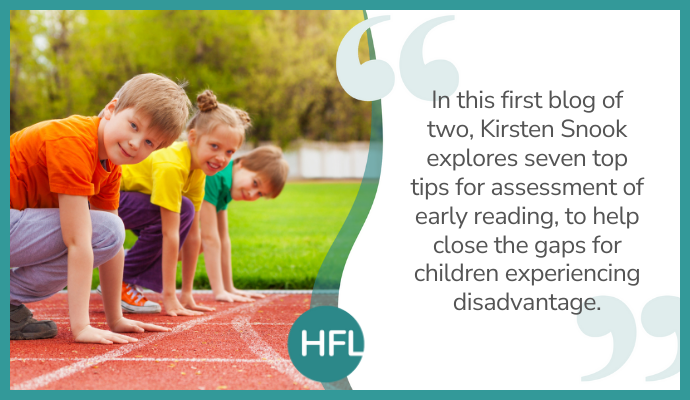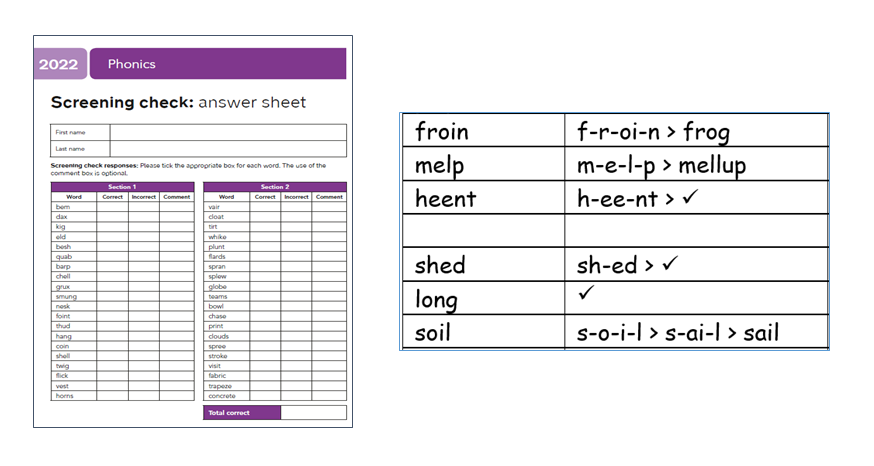
Part 1 Assessment
There’s nothing quite like a global pandemic to wobble one’s confidence with how we’re reaching our arguably hardest-to-reach children. Aspects of pedagogy that once used to reach certain children may not now be able to, or we may not have the resources we once had, or we may find even more children have SEMH needs, financial worries or resilience issues. And some (if not most) children’s experiences through the pandemic count as trauma. All of these things may be sending ‘ripples on the pond’ of our practice, making us feel de-skilled and wondering what more we can do to help children close their gaps. All of these things are increasing the proportion of doubly or triply disadvantaged children, for whom our national advocacy heart aches.
This two-part blog seeks to help in some tiny way, by sharing some of our action-research findings from our early literacy projects over the years.
1. Assessment not assumption
When evaluating on-trackness, it’s not helpful to say to ourselves “I expect” or “I know”. How do you know? We always hope and wish for our children to do well, and sometimes this gives us rose-tinted spectacles. What kind of assessment tools does your school’s chosen SSP have within it? How are these used diagnostically and formatively? What does this tell you about, in terms of feeding the information forward to close gaps?
When delivering practice phonics screening checks – or indeed any assessments - always take the opportunity to note down what the errors were and how they were arrived at, as demonstrated below. This will yield fantastic assessment information (or ‘data’) that tells you not just how they got on with the ‘product’ but also how they are doing with the ‘process’ – they need both in harmony.

2. Let’s get formative
It’s often said in education that ‘weighing the pig doesn’t make it fatter’. What are our tick sheets going to show us? They have a place in showing us a quantifiable measure of how much item knowledge is known, and where the gaps are, and the extent of their blending skills, but there is also a massive place for qualitative assessment. Such assessments as Running Records or Miscue Analyses capture why they are making errors. What has led to the error that needs realigning through modelling, prompting etc? Are they self-monitoring for accuracy/sense? Are they self-correcting? Is there any sign of self-regulation at all...? What are their strengths in phonics (for each of reading and spelling) that can be used as their literacy capital to further strengthen and confirm their feeling of knowing? What are the as-yet-unhelpful reading (or spelling) behaviours that need to be realigned, modelled and prompted for? Now, how do we feed that forward into carefully sculpted prompts for teaching? Then, try to stick to them! Make them yours, and that child’s, mantras for decoding and/or spelling. Soak them in the meta-language that you want to become innate for that child.
3. Be a fan of NOFAN
The ‘NOFAN’ rule of assessment supports the practice of seeking evidence of independent application on several occasions before saying the child’s ‘got it’. This handy acronym stands for ‘Never Occasionally Frequently Always Naturally’, and the further along the ‘continuum of knowing’, the more secure the knowledge (see this previous blog). If we were assessing writing at Year 6 or Year 2, we would not look at one ‘hot write’ and say that child is age-related based on that piece, so why accept discrete, isolated tick sheet assessments as the only basket we put our eggs in? Most children will find it easier to achieve on those assessments than to apply in connected text reading and writing, making the assessment less reliable and valid, but some will not. Some will be at risk of staying stuck in an intervention group for longer than necessary as they are assessed as not passing the assessments but will then read a chapter book almost fluently (for accuracy, always check where the eyes are looking though!). The safest form of assessment is a triangulated one.
4. Hunting not fishing
Dan Nicholls (@DrDanNicholls) has talked and written at length about pro-actively seeking out the information we need, rather than chancing upon it. It’s so important to dig deep into individuals’ profiles and stories. Who is falling behind? Exactly why? Are there wider issues, e.g. attendance or feeling connected to the school community? Do they have some auditory or visual confusions, where they mistake similar-sounding or similar-looking letters for one another? What is their intrinsic motivation like? Who is the main attachment figure they are connected to in school, on the playground, and who invests in their family? Are they able to self-monitor and self-regulate? What is their profile like in terms of learning – stronger in some aspects than others? Where do resources need to be targeted at this current time? Some children will need more (and some very much more) resources than others, hopefully though for time-limited period. We may need to reassure ourselves, and each other, that equity is often about doing whatever it takes in terms of extras, to enable all to achieve the same minimal entitlement (e.g. fluent, accurate reading, leading to lifelong skill, will and thrill) – if this means offering reasonable adjustments and additional teaching time, then so be it.
5. Keepy-uppy
Sometimes children move on faster than we expect! It can be tricky, if you are used to working up close and personal with the same struggling child for a long time, to spot when they may actually be accelerating. This is great! This is your impact in action! But you may need to re-check through ongoing assessments regularly to check whether the pitch is too easy now, as well as too hard. Ensure you capture the evidence of your impact, perhaps in a brief case study, so that you can extrapolate what has worked well and why, and to ensure that people such as governors know the successes and not only the struggles. Tip: when exiting a child from an intervention of any sort, seek to boost their attainment to just slightly above the age-related expectations (ARE) - gleaned of course from a wide range of sources of independent application…your NOFAN! This is as a protective factor against falling too far behind when the inevitable slight slip-back happens, following reduction in support. If they slip back from just above ARE to on track for ARE, then they should still cope in the busy classroom.
6. On the right track
We know it’s essential to identify children who are already struggling to keep up with phonics by week three of Reception (DfE, Ofsted). When children are just getting going off the starting blocks it’s arguably easier to identify who is struggling and what to do about it. For those further up through school, how are we tracking and identifying those falling behind, those making more than typical progress, the impact of interventions and the impact of our school’s chosen SSP? What form of assessment tracker does your SSP come with? And if it doesn’t, have you identified a compatible one? Schemes will come with assessment milestones or indicators (if DfE-validated, this was a stipulation) but a visual representation of on-trackness, or not, is worth its evaluative weight in gold.
7. Go for the jugular!
The true proof of the pudding with phonics and decoding is surely what we see happening in the child’s spelling. Yes, of course there is value in invented spelling – and research has shown time and again the link between invented spelling and later attainment, which maybe just highlights more of that great intrinsic motivation – but also this is the purest picture of how embedded their phonic knowledge truly now is. A piece of independent writing, even after an unaided proofread, will yield far more juicy assessment information than reams of tick-sheets ever will. True, it’ll bring down your assessments a notch or three, but if the overwhelming majority are struggling now to embed the right phonics stuff, then now is the time to adjust, re-group/re-teach etc before the gaps really start to become chasms. And we all know for whom some of these chasms are more likely to become insurmountable… be that advocate.
Next time:
Part two: A….. [yes, that’s right, you’re going to have to come back and find out what the other ‘A’ is!]
This blog was originally published 28th February 2023.
Delivering the phonics screening check to year one pupils
This on-demand recording will give guidance on how to prepare year one pupils for screening check, as well as advice on managing the organisation and the delivery.

